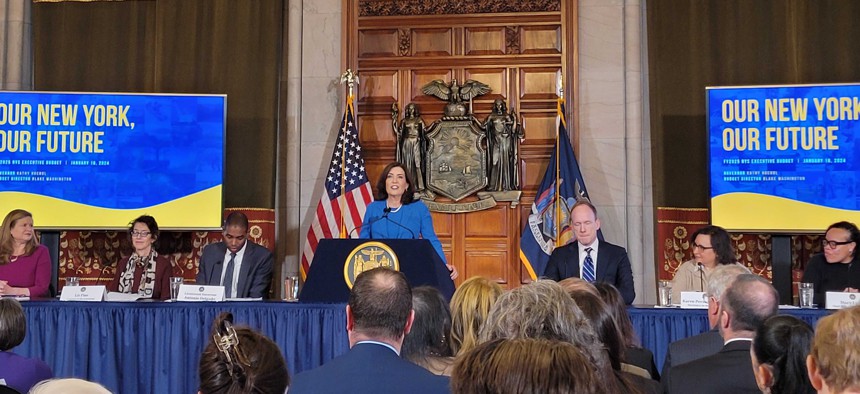Gov. Kathy Hochul unveiled her $233 billion executive budget proposal on Tuesday. It closes a $4.3 billion deficit the state faced. But the spending plan, which covers fiscal year 2025 starting in April this year and ending at the end of March 2025, would be the largest in state history.
Hochul projected fiscal caution while presenting her executive budget in the face of what the state had projected to be a sizable budget hole. Her spending plan included modest growth, but none of the large increases that characterized the past several years. “This will be a $233 billion budget, accomplished without raising income taxes,” Hochul said. “And today, New Yorkers will learn about how we’re presenting a solid, balanced budget without cuts or added burdens.”
Hochul also preempted criticisms that may come from progressives that her proposal amounts to cuts due to the small rate of growth. “We can’t spend like there’s no tomorrow because tomorrow always comes,” Hochul said. She mentioned projected deficits for the next several years, which will hit $9.9 billion by fiscal year 2028 according to her budget plan, as reason for continued fiscal caution. “Our discipline now will keep us out of a deeper hole in the future,” Hochul said.
The state was aided by better than expected tax revenues compared to the mid-year budget assessment from October, which projected the $4.3 billion budget gap. According to the governor’s budget briefing book, the state brought in $2.2 billion more in tax returns than expected. The governor characterized that extra money as a “surplus,” with $1.7 billion going towards pre-payments for fiscal year 2025 and $500 million going towards the state reserves to help with the migrant crisis.
One of the standouts from the budget plan is the $2.4 billion Hochul earmarked for the migrant crisis. She didn’t mention it during her State of the State speech last week except to say that more information would come as part of the budget, so it left many – including New York City Mayor Eric Adams – eager to hear how she would address the ongoing crisis facing the city and state. The funds will be used for shelter, social services and resettlement. Of that, $1 billion will specifically be used to reimburse the city, and $500 million is coming from a one-time withdrawal from the state reserves for emergencies. Between funds committed last year and those promised this year, Hochul said the total state investment into the migrant crisis will hit $4.3 billion.
Hochul’s budget also includes a $825 million increase to school aid, bringing that funding up to a record $35.3 billion. That includes bumping Foundation Aid by $507 million. Building on her State of the State proposal to revamp how literacy is taught in the state, the governor earmarked $10 million to support training teachers in the new reading method. However, education advocates expected education funding to be about $100 million higher, and now await specifics from Hochul to see whether high-need schools will be impacted by lower-than-expected aid. “As much as we may want to, we’re not going to be able to replicate the massive increases of the last two years,” Hochul said of her education funding proposal.
In addition to school funding, Hochul also proposed a four-year extension of mayoral control of schools in New York City. Lawmakers approved a two-year extension in the 2022 legislative session that is set to expire this year. Extending mayoral control of schools is one of Adams’ top priorities in Albany this year, and usually entails fairly significant negotiations with lawmakers before reaching a compromise.
Hochul detailed difficulties with Medicaid spending, which is one of the highest sources of spending in the state. She said that New York spent $1.5 billion more than expected in the past fiscal year on Medicaid, and at least partially laid blame on hospitals for not yet paying back a $1.5 billion loan from the state to financially distressed hospitals as they awaited federal aid. Hochul said the New York State Commission on the Future of Health Care and the New York State Master Plan for Aging are examining how to “maximize our Medicaid dollars and reimagine our delivery system.” Recommendations from those panels won’t impact the upcoming fiscal year.
Like in her State of the State, housing took a back seat in Hochul’s budget proposal. Her spending plan did not include any significant new funding, and she provided few new details on the legislative proposals she initially outlined in her speech last week. According to the budget briefing book, Hochul’s budget “authorizes a new residential construction tax incentive in New York City,” but it provided no details about what such a tax incentive will look like. The governor initially proposed a replacement for the now-expired 421-a developer tax break in 2022, but did not offer a specific pitch last year. However, more details may still come once Hochul releases her actual executive budget bills.
In line with last week's public commitments to public safety, mental health and emerging technology Hochul earmarked $8.5 billion to related programs. That includes $40.2 million to combat retail theft, nearly $36 million for district attorneys to tackle domestic violence and $35 million total related to hate crimes – $10 million increase compared to the previous investment.
This is a developing story.
This is a developing story.
NEXT STORY: Upcoming city, state budgets turn eyes to asylum-seeker dollars


